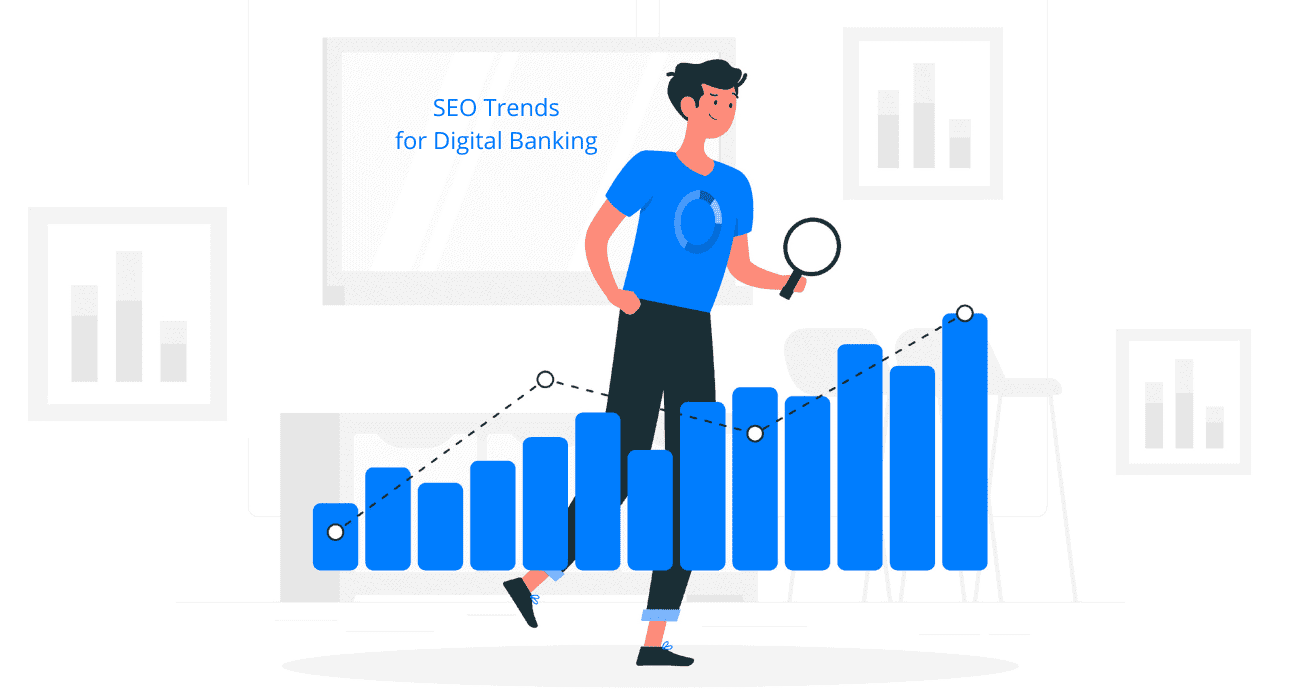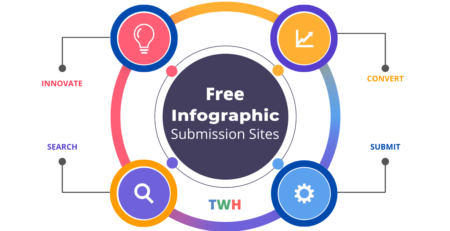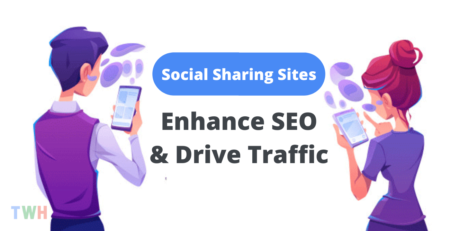Last updated on December 15th, 2023 at 01:47 pm
Explore Top SEO Trends to Follow in 2024 for Digital Banking Industry
Whether you’re in marketing, design, banking, wealth management, software development, fintech, or another facet of the digital banking industry, there are some additional issues to work into your SEO strategy.
The prosperity of any banking institution largely depends on increasing the customer base while retaining the existing customers.
The banking industry has increasingly become more competitive, and customers categorize banks as service providers.
In contemporary times, banks focus on delivering customized banking practices, increasing transparency, and various ad-hoc services to serve the customers.
This makes SEO for the finance industry increasingly important as many banks compete for the same customer base.
Banking institutions must prioritize digital marketing strategies such as SEO to make sure that their audience is aware of the benefits of your banking services provider.
In this article, we’ll go over the top trends in SEO for financial institutions and the importance of digital marketing in the banking sector.
The rise of digital payments in financial institutions has been a major trend in recent years.
Online banking has become more popular than ever before, and banks are investing heavily in digital payment solutions to keep up with the demand.
In this article, we’ll take a look at vital trends that SEO leaders need to observe in the months and years ahead to keep afloat the banking industry and stay in lead.
What is Digital Banking?
Usually, process of banking app development include the following list of services;
That are available to the customer on their mobile phone, computer, or other compatible devices:
- Obtaining bank statements
- Withdrawing cash
- Funding transfers
- Managing your account
- Setting up deposit accounts
- Loan management
- Paying bills
- Cheques management
Digital banking software makes all the traditional banking services convenient to access and manage at the customer’s discretion.
The e-commerce platform allows users to shop online with their cards and pay for goods by simply scanning a barcode.
Some digital payment providers offer features to allow for instant transfers and/or deposits into a user’s bank account.
Are SEO Services Important for Banks?
If your bank’s website does not have an online presence or it is not ranking highly on search engines such as Google, then you may need to re-strategize your SEO strategies to meet your goals.
Conducting effective SEO for banking websites may involve developing plans and strategies that can help your financial institution boost its rankings on Google’s search result page.
Securing a place in the top ranks on Google is vital for your digital banking website.
Since 90% of the platform’s users click on the results that appear on the first page of the search results.
A good ranking may also portray to the banking customer that you have a lot of traffic and the optimal amount of online visibility.
Why Banking Websites Require SEO
The current digital space allows customers any prospective customers to search for banks on Google.
The prospective customer may search for ‘banks around me’ and click on any result that appears on the first page.
If your financial website is not ranking for a particular keyword, you miss out on potential leads.
As a good banker, you do not want to waste any potential leads as they may choose a high-ranking competitor over you.
Any financial institution can always get the services of SEO service providers.
A good SEO company will have the required expertise to help you improve your overall SEO strategy.
Remember that any user searching online for keywords such as ‘best banks’ or ‘banks near me’ can be a potential customer;
And, this is the single most important reason why as a financial institution, you should have good SEO practices.
Now, let’s look at the practical steps that a bank or other financial institution can take to keep up with the trends in the digital banking sector.
The Most Important Trends in SEO for Financial Services
1. Artificial Intelligence
Artificial intelligence and other technological innovations are important tools that can help a financial institution improve its SEO practices.
AI can help search engines such as Google better understand the reasoning behind the phrases consumers type into the search engine or utter.
Financial institutions must therefore utilize artificial intelligence services or risk losing places regarding search rankings and results.
Today’s consumers typically start their inquiries online regarding just about anything from mortgages and loans to debit transactions.
Therefore, banks must rank well with good SEO patterns to grab the attention of potential leads.
In addition, AI gives financial institutions a cost-effective way of addressing the needs of clients who appear to want more accessible and better ways to get, use up and save their money after they have invested online.
2. Video Marketing
Modern consumers spend much of their time on websites and pages containing videos.
Based on this statistic, a financial institution can start developing content for its website and social media accounts.
In formal writing, the message of financial institutions such as banks may seem a bit difficult to understand.
Therefore, utilizing images and videos to promote your finance organization will go a long way in assisting prospective customers as well as current clients in understanding your offerings better.
In addition, video marketing will help your platform grow in visibility.
Video platforms can also help your digital banking site to establish itself as a trusted advisor by clarifying tough financial matters that your audience finds important.
Remember, it is a proven fact that individuals respond better to infographics compared to text, and the same applies to banking customers.
The infographics will make it easier for information to be understood by the customer, and it will improve their online presence on your site.
3. Answer Consumer Queries
Regarding professional content, search engines such as Google want to ensure that consumers can get all their information from one source.
This is why forum websites that address questions are taken more seriously regarding search results and rankings.
What implications does this have for financial institutions in terms of marketing?
Answering consumer queries involves coming up with in-depth, high-quality content that answers the questions your intended audience may have on an assortment of topics.
Google search engine launched the Multitask Unified Model, a processing solution that alleviates long format questions by helping provide the answers.
According to Google, an average consumer can make eight inquiries to complete many hard activities.
Using the Multitask Unified Model, Google predicts that it can solve more complicated queries in one web search.
4. Optimize Your Keywords
Before you embark on any other marketing strategy for your digital banking website, you must first consider the keywords that will propel your bank to the top of Google’s search page.
This will require you to do due diligence and research the audience to develop a feasible keyword strategy.
A carefully planned keyword strategy will make available the long tail keywords that most prospective customers search on online platforms.
In addition, you can use tools like Ahrefs, Ubersuggest, or any other to perform a keyword search.
These, among other tools, will give you good keyword ideas, and they can also show you what keywords your leading competitors are using to rank highly on Google.
It may be tricky to narrow down on what keywords to use, but with persistent effort, you can develop a suitable set of keywords that will suit your website.
Once you have come up with a list of keywords, the next step is to include them on your website.
Note that this does not mean that you should use keywords excessively.
Avoid stuffing many keywords in the website content, as doing so can get your website blacklisted by Google.
Remember that in the grand scheme of things, being blacklisted is worse than not getting ranked by the search engine.
Apply the keywords in the areas of your content where they will make sense, and do not use them purely for SEO benefits.
5. Generate Content That is Unique and Exciting
If you are looking to solidify your place in the top ranks on a search engine like Google and increase targeted traffic to your site;
Then you must include high-quality content that will be of value in terms of information to the user.
You can make financial tips available on your banking site’s blog to achieve this.
Similarly, you can also include the benefits a customer will enjoy when using your bank’s services.
You can also post Frequently Asked Questions;
As this information will be especially useful to readers visiting your site for the first time and users who want to obtain additional information that may not be available on your blog page.
Your content should be unique, creative, and, most importantly, useful to the readers.
In general, the higher the number of pages and content included on your website, the more traffic you generate.
6. Mobile Adaptability
This is a key aspect of top SEO trends in the digital banking industry .
One of the main things that Google or any other search engine looks at when ranking websites is how responsive the website is.
In addition, Google has now established that its crawlers currently use the mobile version of a website to determine its indexing.
For banking SEO, this means that websites that are not responsive across different devices such as tablets and smartphones may very well find themselves in the inner pages regarding search results.
Remember that modern customers use their mobile phones for nearly everything, be it hailing a cab or searching the internet for their local bank.
So, for a financial institution to employ SEO best practices, it must take advantage of mobile technology and ensure its website is available and responsive on mobile platforms.
7. Seek Out Backlinks for Your Site
When it comes to financial services SEO;
It would be beneficial if the institution creates and requests backlinks for their web page, as this is a proven SEO strategy.
To do this, you will have to seek out a reputable and credible site that will consent to give you backlinks on their site.
Doing so will be beneficial to your site since if you secure backlinks from a popular website, you will increase your site’s credibility.
In addition, good backlink building will aid Google track down your pages more quickly since you have linked them to better websites.
Securing good backlinks can help move some of your deeper ranking pages to better rankings when they are linked to more popular pages on your website.
Another good strategy to get a quality link is creating a social network profile, as this will propel the official channels to the highest optimization levels.
Lastly, your website may gain great credibility if you can obtain links from relevant institutions, research sites, government sites, or universities.
Takeaway
The steps listed above are good SEO practices that align with the banking industry’s current trends.
Applying them correctly will be very effective in the long term and take your financial institution to the next level.
I can expect to see more improvements in digital payment method in the future as well.
More people are using this payment methods, such as online banking, debit cards, and online shopping.
This is because of the convenience it offers and its ease of use.
Emerging technologies like Bitcoin are making it possible for individuals to store their wealth outside of the current financial system.
As a result, people are increasingly looking to use cryptocurrency as an investment option or as a means of payment.
Finally, I hope these SEO trends for digital banking industry websites will surely give you the extra-ordinary results.











